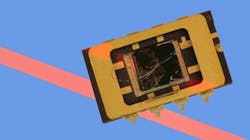New 700-nm-emitting MoS2 LED could be interesting for silicon photonics
A group at Ecole Polytechnique Federale de Lausanne (EPFL; Lausanne, Switzerland) that has been exploring the properties and uses of the semiconductor molybdenum disulphide (MoS2) has now created both LEDs and photovoltaic cells using a 2D (atomically thin) monolayer of MoS2 coated on silicon (with silicon dioxide placed in between in some spots as an electrical insulator).1
LED could be useful in silicon photonics
Previously, EPFL professor Andras Kis and his team in the Laboratory of Nanoscale Electronics and Structures (LANES), had made an electronic chip, a flash memory device, and an image sensor from MoS2, which has a direct bandgap. Their new LED, which has vertical heterojunctions consisting of n-type monolayer MoS2 and p-type silicon, emits in a 250 nm band with a peak centered at 700 nm (the first prototype has a low efficiency), while the solar cell reaches an efficiency of 4%.
As for the LED, “This light production is caused by the specific properties of molybdenite,” says Kis. “Other semiconductors would tend to transform this energy into heat.”
And the solar cell: "Molybdenite and silicon are truly working in tandem here,” notes Kis. "The MoS2 is more efficient in the visible wavelengths of the spectrum, and silicon works more in the infrared range; thus the two working together cover the largest possible spectral range.”
The scientists want to try to create MoS2 integrated emitters for silicon photonics devices, as well as develop MoS2 LED bulbs.
REFERENCE:
1. Oriol Lopez-Sanchez et al., ACS Nano (2014); doi: 10.1021/nn500480u

John Wallace | Senior Technical Editor (1998-2022)
John Wallace was with Laser Focus World for nearly 25 years, retiring in late June 2022. He obtained a bachelor's degree in mechanical engineering and physics at Rutgers University and a master's in optical engineering at the University of Rochester. Before becoming an editor, John worked as an engineer at RCA, Exxon, Eastman Kodak, and GCA Corporation.
